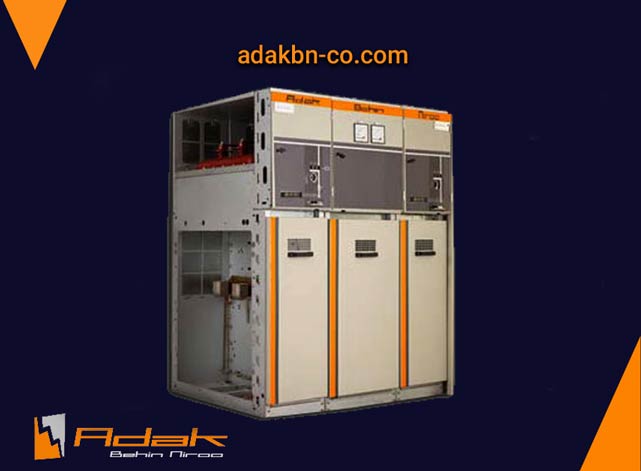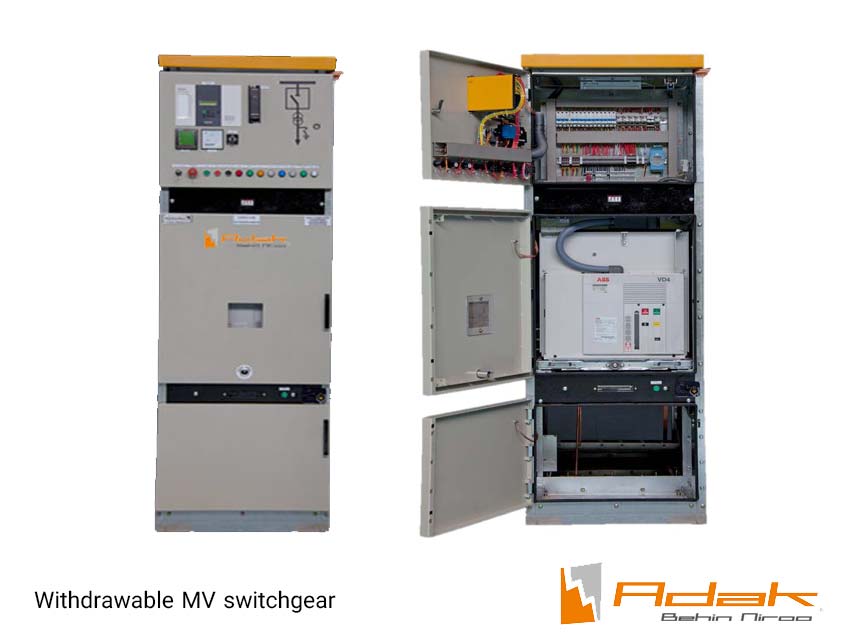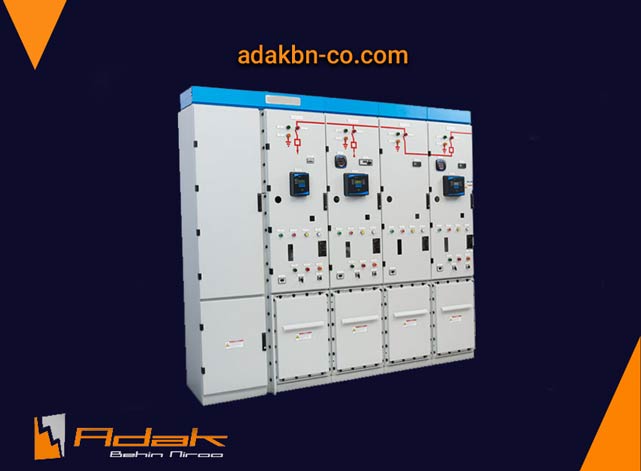What is medium voltage switchgear?
فهرست مطالب
- 1 Everything about medium voltage switchboards
- 2 Medium voltage switchgear
- 3 Electrical switchgear voltage classes according to ANSI and IEEE standards
- 4 What are the types of medium voltage switchgear ?
- 5 GIS gas insulation electrical panel
- 6 Metal Clad Medium voltage switchgear
- 7 Metal Enclosed switchgear
- 8 Pad-Mounted Switchgears
- 9 Pad-Mounted electrical panel features
- 10 Subsurface medium voltage switchboard
- 11 Arc resistant switchboard: ANSI / IEEE C37.20.7
- 12 Classification in ANSI / IEEE standard C37.20.7
- 13 Type of insulation used in medium voltage switchboards
- 14 Air insulation features
- 15 Gas insulation in medium voltage electrical panel
- 16 Liquid insulation and its properties
- 17 Mineral oil insulation
- 18 Fluid insulation E200
- 19 Liquid insulation FR3
- 20 Circuit breakers in medium voltage switchboards
Everything about medium voltage switchboards
A medium voltage switchgear is a set of electrical equipment enclosed in a predominantly metal structure. This centralized set includes a variety of switches, transformers, fuses and circuit breakers. Electrical panels are used to better protect, control and separate electrical equipment from each other. Electrical switchgears are commonly found throughout power transmission and distribution systems, as well as in medium to large commercial or industrial facilities. In this article, we will introduce and review the types of medium voltage electrical panels and its relevant standards.

MV fixed switchgear by ADAK
Medium voltage switchgear
In addition to protecting the electrical equipmFent inside, the electrical panel is responsible for the proper transmission and distribution of electrical energy to various facilities. Also, a medium voltage switchgear protects electrical personnel and equipment well by limiting the electrical current system to a safe level.

adakbn-co.com
Electrical switchgear voltage classes according to ANSI and IEEE standards
The ANSI and IEEE standards specify the voltage classification of electrical panels as follows:
- Low voltage switchboard: up to 600 volts
- Medium voltage: between 600 volts to 69 kV
- High voltage: between 69 kV to 230 k
Ultra-high voltage and ultra-high voltage classes are also defined in the ANSI / IEEE standards. However, NEC 2014 extended the definition of low voltage switchboards to 1000 volts.
you may also like: switchgear maintenance
What are the types of medium voltage switchgear ?
Depending on the type of application and the internal structure of the medium voltage switchboard, the following types of categories can be done for it.
GIS gas insulation electrical panel
This type of medium voltage switchgear has sealed chambers filled with sulfur hexafluoride (SF6) or a mixture of SF6 and other insulating gases that have recently been introduced to the market. Gas-sealed chambers make the installation process easier and take up less space. Gas insulated electrical panels are designed and tested according to ANSI C37.60 and C37.72 standards. Prior to the definition of IEEE C37.20.9 for gas insulated electrical switchboards in the summer of 2019, GIS switchboards were designed, manufactured and tested according to IEC 62271.

Metal Clad Medium voltage switchgear
Metal Clad switchgear is defined by IEEE C37.20.2. This standard refers to the process of making a medium voltage switchgear in which all electrical components are enclosed in separate metal enclosures. These include the input bus, the output bus, the measuring instrument, and the main circuit breaker or switch. This is to provide an extra level of safety, efficiency and ease of maintenance. The nominal voltage level for a metal cold switchboard varies from 5 kV to 38 kV. Metal Clad switchboards have three circuit breakers for ease of maintenance and are often used in industrial facilities and power plants and transmission lines.
Metal Enclosed switchgear
Panel enclosed with metal or Metal Enclosed panel is defined according to IEEE C37.20.3. This type of medium voltage switchboard includes protective devices such as circuit breakers, electrical fuses and various transformers, as well as control and measurement equipment. These devices can also be installed in shared enclosures and there is no need for separations similar to what is done in a Metal Clad switchboard. Metal enclosed panels are used in many commercial and industrial installations where the input power supply is above 480/600 volts.
Pad-Mounted Switchgears
The pad -mounted switchgears is defined by the IEEE C37.74 standard. The medium voltage switchboard mounted on the pad is designed for underground distribution systems with a voltage of 5 to 38 kV. Outdoor Usage, low complexity and high temperature resistance make this product an ideal choice for use in distribution and control lines.
Pad-Mounted electrical panel features
Switches, fuses and circuit breakers in this type of medium voltage switchboard are optimized to protect the steady current, find faults and minimize circuit breakers. Pad-equipped switchboards are available through a maximum of 6 methods in a common insulated tank. The types of insulation used include air, SF6 gas, liquid, solid dielectric technology in air, and solids.

Subsurface medium voltage switchboard
Medium voltage subsurface switchboard is defined by IEEE C37.74. The subsurface switchboard is designed for power distribution systems with a voltage of 15 to 38 kV. The design of this electrical panel is such that there can be proper operation of the device and its accessories underground. These places can be dry or exposed to water. The subsurface medium voltage switchboard can also allow the user to control the device from the ground manually or by using relays and eliminate possible defects. Common types of insulation in this type of medium voltage electrical panel include SF6 gas, solid dielectric technology in air and solids.
Arc resistant switchboard: ANSI / IEEE C37.20.7
Conventional electrical panels are made to IEEE (North American) or IEC (European and other parts of the world) standards and provide a relatively safe environment for equipment and maintenance personnel in normal working conditions. However, a conventional electrical panel is not designed to withstand the enormous amount of energy released during a power failure.
Arc-certified electrical switchboards are designed to restrain the sudden energy of the arc with ease and prevent damage to the operator and equipment. This is usually done by directing the sudden energy of the arc through the plenum to an area that can be released without harming personnel or equipment.
Classification in ANSI / IEEE standard C37.20.7
- Type 1 – Only on the front of the equipment should be arc resistant.
- Type 2 – The entire circumference of the equipment must be arc resistant.
- Type 2B – The system must be arc resistant in all parts, even in the parts of the tool box or control door.
- Type 2C – must be arc-resistant between adjacent enclosures within the system as well as in its surroundings.
In addition, remote racking can be used for operations such as disconnecting, testing and reconnecting circuit breakers and auxiliary enclosures of Metal Cold switchboards from a distance of 7-9 meters.
Type of insulation used in medium voltage switchboards
Insulation environment is the environment inside the medium voltage switchboard housing that is used to protect equipment with electrical energy such as bushings, bass, etc. from unwanted arc movements. While air is the most common insulation, gas and fluid insulation provides higher dielectric strength to make switchboard structures smaller. Liquids also provide a cooling advantage.
Air insulation features
Air is the most common and least expensive insulation. However, air also has the lowest dielectric resistance, and more complex and physically larger equipment is needed to withstand the effects of the arc.
Gas insulation in medium voltage electrical panel
Gas insulation significantly improves dielectric resistance compared to air. The gas most commonly used as a panel insulation is sulfur hexafluoride (SF6). Any electrical impact is sealed inside a tank with pressurized SF6 gas. The special design of this sealed tank also eliminates the need for contactor maintenance.
Liquid insulation and its properties
Liquids offer better dielectric properties than air. At the same time, they bring the advantage of cooling the system. Although we often refer to liquid as oil, different liquids are actually used to insulate electricity in low voltage switchboards as well as transformers and other devices. It is very important that the selected liquids are fireproof and environmentally friendly.
Mineral oil insulation
It is an oil-based insulation and has been proven to work well over time and has reliable electrical insulation properties.
Fluid insulation E200
A low viscosity, non-toxic, non-biodegradable, biodegradable polyester based liquid with excellent dielectric, thermal and physical properties. The low viscosity of the E200 allows it to be used in medium voltage switchboards up to -30 ° C. Its flash point is more than 300 degrees Celsius (572 degrees Fahrenheit). As a result, the risk of fire due to its use is not conceivable.
Liquid insulation FR3
Insulation is composed of edible vegetable oils and additives used for food grade food. It does not contain any oil, halogen, silicon or any other toxic substance. This substance is rapidly and completely eliminated in soil and water environments. This liquid also came out of the toxicology tests of liquids, proud.
Circuit breakers in medium voltage switchboards
Switching devices cut off the power supply and include overcurrent protection devices (fuses, circuit breakers) and switches.
Air switch
An air switch is a switching device that uses air as a dielectric. Air switches typically have less downtime than oil or vacuum switches, yet are more economical and provide a reliable means of disconnecting.
Fuses in MV switchboards
A fuse is a device that cuts off current flow. The current is cut off by melting a wire or electrical tape designed to melt at a specified temperature / time. In a medium voltage switchboard, the fuses are usually coupled to a switch to take advantage of both overcurrent protection and the ability to open and close the circuit.
Oil switch
It is a switching device that is immersed in a chamber full of oil. Oil switches are often installed in medium voltage switchboards. In it, it is possible to make oil insulation in the form of a compact chamber with low complexity.
Vacuum circuit breaker
It is a type of circuit breaker in a medium voltage switchboard in which there is an interruption and interruption of the arc inside the isolated vacuum bottles. The vacuum causes the arc to disappear quickly and its energy to decrease very quickly. Vacuum circuit breakers can cut voltages much higher than air type circuit breakers. They also require significantly less space.
Vacuum fault interrupter
This component eliminates the need for a separate fuse and switch at the same time, both as an overcurrent protection device and as a circuit breaker.
Intelligent medium voltage switchboard
The inclusion of intelligent electronic devices (IEDs) such as smart circuit breakers, sensors and relays, and microprocessor-based meters can make medium voltage switchboards smarter. This can be done in new switchboard designs as well as by strategically upgrading specific components in existing medium voltage switchboard systems. Network switchboards allow facility operators to use advanced cloud computing solutions that can analyze large amounts of data and provide operational insights into the power distribution system to improve efficiency, safety, and Use operational performance.
Head Quarters: Unit 1 & 3, 199 Kaj Boulevard, Azimieh, Karaj, Iran
Tel: 02634156000
Email: info@adakbn-co.com
Tehran Office: Unit 6, 10 Mokhberi St., Ashrafi Esfahani Hwy, Tehran, Iran
Tel:+982144498064
Email: sales@adakbn-co.com
 آداک بهین نیرو
آداک بهین نیرو
طراح و سازنده انواع تابلو برق صنعتی در ایران




